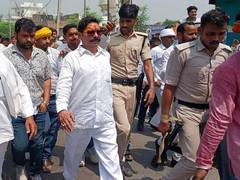Railway Minister Ashwini Vaishnaw to visit Hyderi Manzil on occassion of Gandhi Jayanti
Kolkata (West Bengal) [India], October 2 (ANI): On the occasion of Mahatma Gandhi’s 155th birth anniversary – Gandhi Jayanti, Railway Minister Ashwini Vaishnaw will be visiting Hyderi Manzil.
Also known as Gandhi Bhavan, the Hyderi Manzil, located in the Beliaghata neighbourhood here holds historical significance as it is the place where Mahatma Gandhi stayed during a critical period of India’s independence in August 1947.
Mahatma Gandhi stayed for a few weeks in 1947 in an effort to quell communal tensions. It was renamed Gandhi Bhavan to honour him.
The residence was owned by Hoosaina Bengali, a member of the Dawoodi Bohra community where Mahatama Gandhi arrived on August 13, 1947 and spent 25 days, staying through the momentous occasion of India’s independence on August 15.
On the day of independence, while the country celebrated, Gandhi chose to fast and pray in response to the communal violence that was erupting in the region.
His presence at Hyderi Manzil attracted people from all walks of life, including politicians, students, and intellectuals, who came to meet and seek guidance from him.
Although he initially managed to calm the situation, violence re-emerged on August 31, leading him to declare an indefinite fast on September 1 to bring lasting peace. Gandhi’s fast ended on September 4, after local leaders surrendered their weapons at his feet.
Hyderi Manzil has since been converted into a museum, dedicated to preserving the legacy of Gandhi’s time in Calcutta.
The museum exhibits rare photos of the leader during his stay in 1947 here, the items used by him in his stay at the Sodepur ashram, the letters of correspondence during the turmoil period in Calcutta and Noakhali.
This museum offers a comprehensive glimpse into Gandhi’s pivotal role in the fight for communal harmony during one of India’s most challenging periods.
Newspaper clippings documenting the state’s turbulent history, glass case displaying swords surrendered to Gandhi by the rioters and interactive systems and frescoes depicting the non-violent movements are also exhibited in the museum.
Additionally, the walls of the museum are adorned with paintings of the 1947 communal violence created by the students of Visva Bharati University.






